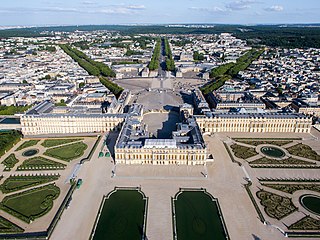
A château is a manor house or residence of the lord of the manor, or a fine country house of nobility or gentry, with or without fortifications, originally, and still most frequently, in French-speaking regions.
A historic house generally meets several criteria before being listed by an official body as "historic." Generally the building is at least a certain age, depending on the rules for the individual list. A second factor is that the building be in recognizably the same form as when it became historic. Third is a requirement that either an event of historical importance happened at the site, or that a person of historical significance was associated with the site, or that the building itself is important for its architecture or interior. Many historic houses are also considered museums and retain permanent collections that help tell the story of their house and the era.
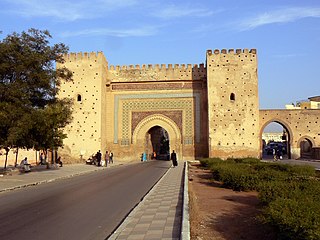
Meknes is one of the four Imperial cities of Morocco, located in northern central Morocco and the sixth largest city by population in the kingdom. Founded in the 11th century by the Almoravids as a military settlement, Meknes became the capital of Morocco during the reign of Sultan Ismail Ibn Sharif (1672–1727), son of the founder of the Alaouite dynasty. Sultan Ismail created a massive imperial palace complex and endowed the city with extensive fortifications and monumental gates. The city recorded a population of 632,079 in the 2014 Moroccan census. It is the seat of Meknès Prefecture and an important economic hub in the region of Fès-Meknès.

A mansion is a large dwelling house. The word itself derives through Old French from the Latin word mansio "dwelling", an abstract noun derived from the verb manere "to dwell". The English word manse originally defined a property large enough for the parish priest to maintain himself, but a mansion is no longer self-sustaining in this way. Manor comes from the same root—territorial holdings granted to a lord who would "remain" there.

A manor house was historically the main residence of the lord of the manor. The house formed the administrative centre of a manor in the European feudal system; within its great hall were usually held the lord's manorial courts, communal meals with manorial tenants and great banquets. The term is today loosely applied to various English country houses, mostly at the smaller end of the spectrum, sometimes dating from the Late Middle Ages, which currently or formerly house the landed gentry.

An English country house is a large house or mansion in the English countryside. Such houses were often owned by individuals who also owned a town house. This allowed them to spend time in the country and in the city—hence, for these people, the term distinguished between town and country. However, the term also encompasses houses that were, and often still are, the full-time residence for the landed gentry who dominated rural Britain until the Reform Act 1832. Frequently, the formal business of the counties was transacted in these country houses, having functional antecedents in manor houses.

The Museum of Marrakech is a historic palace and museum located in the old center of Marrakesh, Morocco. In addition to its notable architecture, the museum's collection showcases various historic art objects and contemporary art from Morocco.

Châteauesque is a Revivalist architectural style based on the French Renaissance architecture of the monumental châteaux of the Loire Valley from the late fifteenth century to the early seventeenth century.

Fes el Bali is the oldest walled part of Fez, the second largest city of Morocco. Fes el Bali was founded as the capital of the Idrisid dynasty between 789 and 808 AD. UNESCO listed Fes el Bali, along with Fes Jdid, as a World Heritage Site in 1981 under the name Medina of Fez. The World Heritage Site includes Fes el Bali's urban fabric and walls as well as a buffer zone outside of the walls that is intended to preserve the visual integrity of the location. Fes el Bali is, along with Fes Jdid and the French-created Ville Nouvelle or “New Town”, one of the three main districts in Fez.
This article covers the architecture of Estonia.
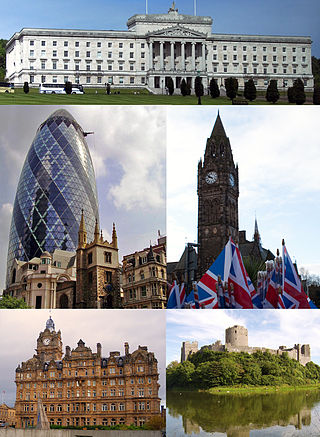
The architecture of the United Kingdom, or British architecture, consists of a combination of architectural styles, dating as far back to Roman architecture, to the present day 21st century contemporary. England has seen the most influential developments, though Ireland, Scotland, and Wales have each fostered unique styles and played leading roles in the international history of architecture. Although there are prehistoric and classical structures in the United Kingdom, British architectural history effectively begins with the first Anglo-Saxon Christian churches, built soon after Augustine of Canterbury arrived in Great Britain in 597. Norman architecture was built on a vast scale throughout Great Britain and Ireland from the 11th century onwards in the form of castles and churches to help impose Norman authority upon their dominions. English Gothic architecture, which flourished between 1180 until around 1520, was initially imported from France, but quickly developed its own unique qualities.
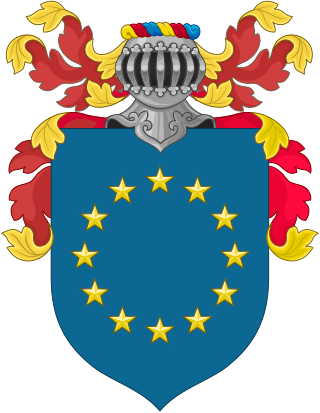
The Historic Hotels of Europe (HHE) is an umbrella organisation established to promote like-minded independent hotel associations throughout Europe. Castles, manors, convents, palaces, monasteries, townhouses, villas and residences which have maintained their historic character are part of the HHE.
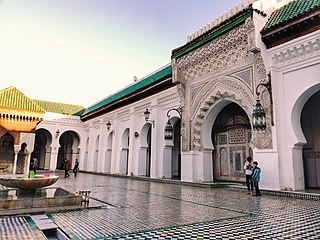
Fez or Fes is a city in northern inland Morocco and the capital of the Fès-Meknès administrative region. It is the second largest city in Morocco, with a population of 1.11 million, according to the 2014 census. Located to the northwest of the Atlas Mountains, it is surrounded by hills and the old city is centered around the Fez River flowing from west to east. Fez has been called the "Mecca of the West" and the "Athens of Africa". It is also considered the spiritual and cultural capital of Morocco.

The architecture of Fez, Morocco, reflects the wider trends of Moroccan architecture dating from the city's foundation in the late 8th century and up to modern times. The old city (medina) of Fes, consisting of Fes el-Bali and Fes el-Jdid, is notable for being an exceptionally well-preserved medieval North African city and is classified as a UNESCO World Heritage Site. A large number of historic monuments from different periods still exist in it today, including mosques, madrasas, synagogues, hammams (bathhouses), souqs (markets), funduqs (caravanserais), defensive walls, city gates, historic houses, and palaces.

Dar Glaoui or Glaoui Palace is a late 19th-century and early 20th-century palace in Fez, Morocco. It was owned by the Glaoui family, whose most famous members were the Grand Vizier Madani and his brother Thami, pasha of Marrakech. The palace is located in the southwestern district of Fes el-Bali, in an area containing other historic mansions.












